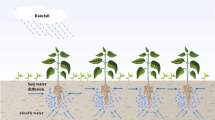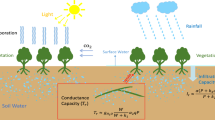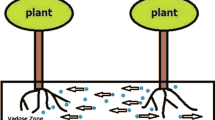Abstract
Assume that an oasis and its surrounding desert consist of an isolated system without mass and energy exchange with the outer environment. The characteristics of oasis evolution have been explored under the condition of system energy conservation. The results show that oasis evolves with two equilibrium states. The first equilibrium suggests a stable expansive and an unstable degraded oasis whereas the second equilibrium indicates a stable shrink and an unstable increase of the oasis area. If one equilibrium state is unstable, the components of the isolated system (oasis and desert) would tend to be no energy exchange and they each reach to energy balance respectively. Oasis would maintain its initial area in this case. Further analyses point out that the two equilibrium states have completely different characteristics. In the first equilibrium state, a higher vegetation albedo, lower soil albedo and larger canopy resistance, and direr soil both contribute to the oasis area expansion, accompanying an excessive large desert soil and vegetation canopy temperature difference (SCTD). In the second equilibrium state, however, a lower vegetation albedo, higher soil albedo and small canopy resistance, and wetter soil benefit the oasis area to stay near its initial value, following a moderate SCTD. The convergent trajectories of the initial values in phase space are influenced by the separatrices of the equilibrium points. Higher temperature is an advantage factor for initial values convergent to the oasis expansion solution.
Similar content being viewed by others
References
Barton I J. 1979. A parameterization of the evaporation from nonsaturated surfaces. J Appl Meteorol, 18: 43–47
Chao J, Zhou D. 2005. A simple analytical theory of coupling between the atmosphere boundary layer and plant (in Chinese). Chin J Atmos Sci, 29: 37–46
Charney J G. 1975. Dynamics of deserts and drought in the Sahel. Quart J Roy Meteor Soc, 101: 193–202
Chen X. 2012. Retrieval and Analysis of Evapotranspiration in Central Areas of Asia. Beijing: China Meteorological Press. 7–9, 21–24
Dai Y, Zeng Q, Wang B. 1997. A simple land surface model for use in AGCM (in Chinese). Chin J Atmos Sci, 21: 705–716
Dai Y, Zeng X, Dickinson R E. 2001. Common Land Model (CLM). CLM technical documentation and user’s guide
Dickinson R E, Henderson A H, Kennedy P J, et al. 1993. Biosphere-atmosphere transfer scheme (BATS) version 1e as coupled to community climate model. NCAR Technical Note
Dickinson R E. 1984. Modeling evapotranspiration for three-dimensional global climate models. Geophys Monogr Ser, 29: 58–72
Fan S. 1989. A new extracting formula and a new distinguishing means on the one variable cubic equation (in Chinese). Nat Sci J Hainan Teachers Coll, 2: 91–98
Fan Z. 1993. A study on the fromation and evolution of oases in Tarim Basin (in Chinese). Acta Geogr Sin, 48: 421–427
Gao H. 1987. The distribution and types of oases in China (in Chinese). Arid Land Geogr, 10: 23–29
Han D. 1999. The progress of research on oasis in China (in Chinese). Sci Geogr Sin, 19: 313–319
Huang R, Chen W, Ma Y, et al. 2011. Interaction Between Land and Atmosphere Over Arid Region in Northwestern China and its Impact on East Asia Climate Change. Beijing: China Meteorological Press. 7–27
Liu S, Liu S. 2011. Atmospheric Dynamics. 2nd ed. Beijing: Peking University Press. 548
Monteith J L. 1981. Evaporation and surface temperature. Quart J Roy Meteor Soc, 107: 1–27
Mu G, Liu J. 2000. An analysis of the oasis evolution and its control factors (in Chinese). Quat Sci, 20: 539–547
Noilhan J, Planton S. 1989. A simple parameterization of land surface processes for meteorological models. Mon Weather Rev, 117: 536–549
Pan X L, Chao J P. 2001. The effects of climate on development of ecosystem in oasis. Adv Atmos Sci, 18: 42–52
Penman H L. 1948. Natural evaporation from open water, bare soil and grass. Science, 193: 120–145
Shen Y. 1994. The discussion of the concept of oasis (in Chinese). Arid Land Geogr, 17: 70–74
Wang Y, Zeng F. 2010. Analysis and progress of oasis research in China (in Chinese). Arid Zone Res, 27: 501–506
Wu L, Chao J, Fu C, et al. 2003. On a simple dynamics model of interaction between oasis and climate. Adv Atmos Sci, 20: 775–780
Wu L, Chao J. 2004. The oasis and desert effect in a simple dynamics model of interaction between oasis and climate (in Chinese). Clim Environ Res, 2: 350–360
Yasuda N, Toya T. 1981. Evaporation from non-saturated surface and surface moisture availability. Pap Meteorol Geophys, 32: 89–98
Zhang Q, Hu Y, Hou P. 2003. Analysis on maintenance mechanism of oasis by nonlinear thermodynamics (in Chinese). J Des Res, 23: 174–181
Zhang Q, Hu Y. 2002. The geographical features and climatic effects of oasis (in Chinese). Adv Earth Sci, 17: 477–486
Zhang R, Zuo Z. 2011. Impact of spring soil moisture on surface energy balance and summer monsoon circulation over East Asia and precipitation in East China. J Clim, 24: 3309–3322
Zuo Z, Zhang R, Zhao P. 2011. The relation of vegetation over the Tibetan Plateau to rainfall in China during the boreal summer. Clim Dyn, 36: 1207–1219
Author information
Authors and Affiliations
Corresponding author
Rights and permissions
About this article
Cite this article
Li, Y., Chao, J. The dynamical evolution theory of the isolated oasis system. Sci. China Earth Sci. 58, 436–447 (2015). https://doi.org/10.1007/s11430-014-4941-1
Received:
Accepted:
Published:
Issue Date:
DOI: https://doi.org/10.1007/s11430-014-4941-1




